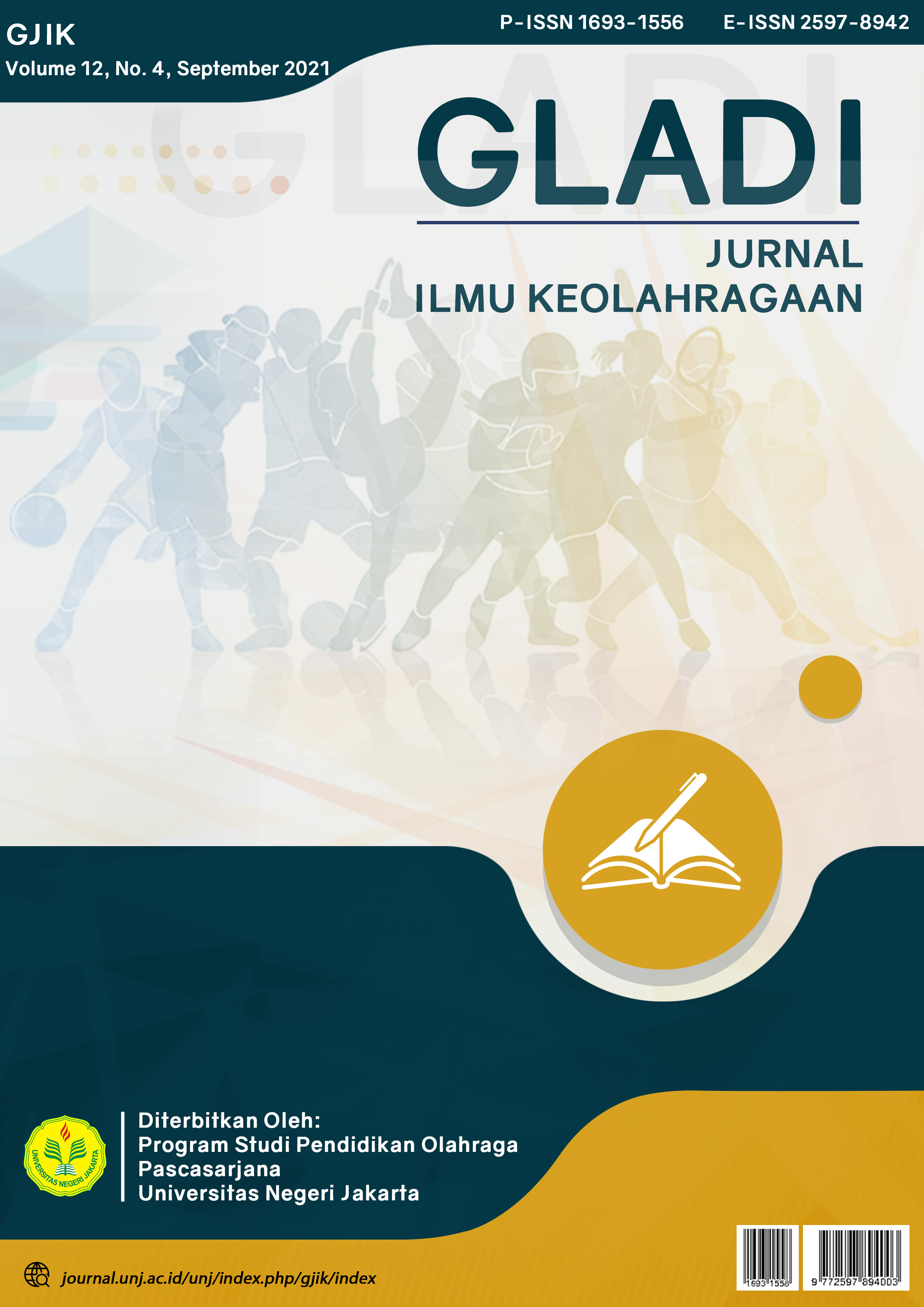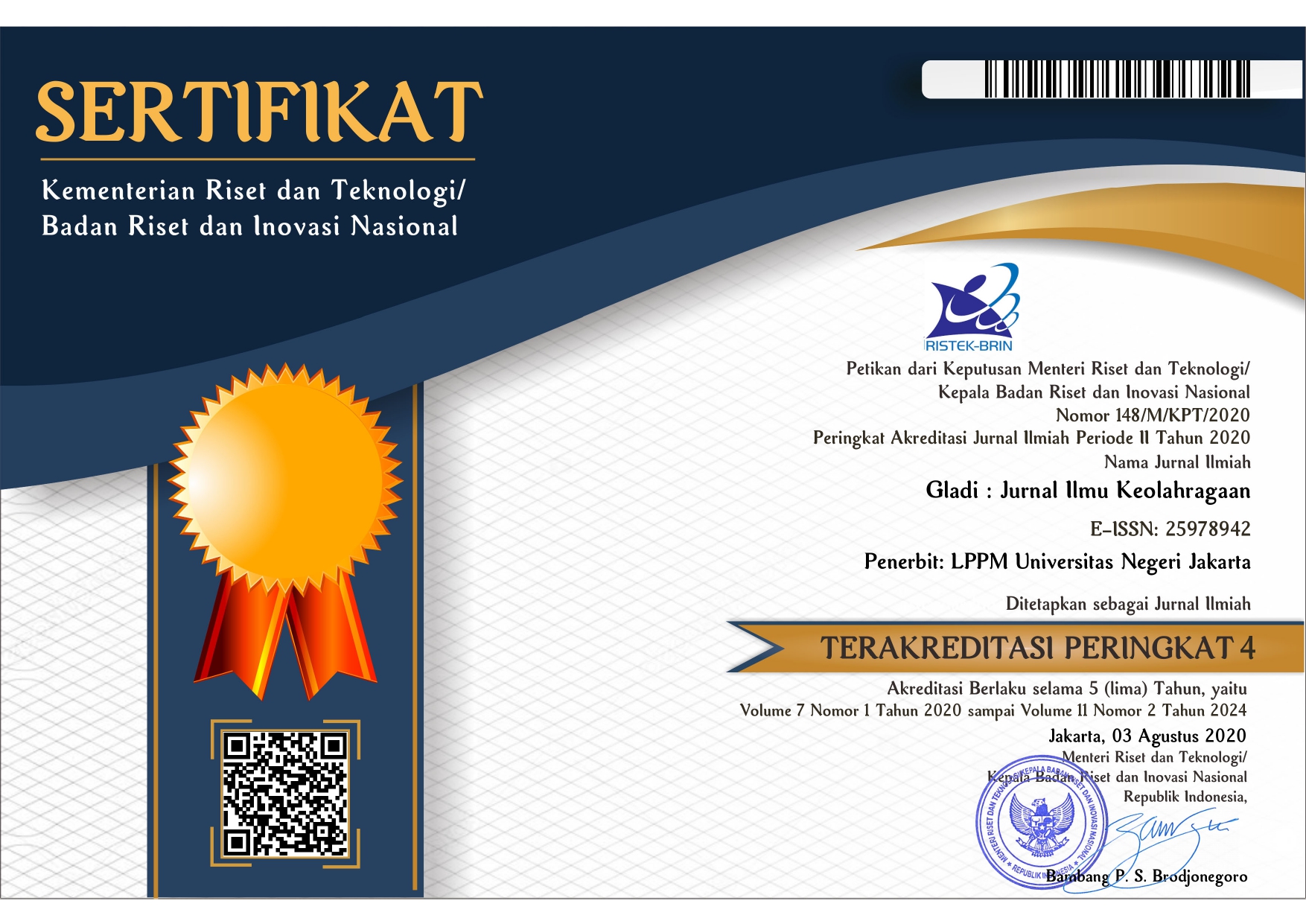BADMINTON SMASH SKILL TRAINING MODEL FOR HIGH SCHOOL BEGINNERS STUDENTS
DOI:
https://doi.org/10.21009/GJIK.124.03Keywords:
exercise model; skills; badminton smashes; novice athlete; high schoolAbstract
The purpose of this study was to produce a product form of a badminton smash skill training model for high school beginners students (SMA) and to test the effectiveness of the developed training model. The author uses a development research design that adopts the development design of the ADDIE method (Analysis, Design, Development, Implementation, Evaluation) by including high school athletes with the criteria and requirements for beginner athletes aged 14-17 years. At the model feasibility stage, 30 subjects were included to apply the model, 3 badminton experts were used as the validity of each model item, while at the effectiveness test stage 90 subjects were included. Data analysis was carried out descriptively qualitatively through documentation, interviews, and observations, while quantitative data to determine the difference in average skills was carried out using a paired sample test which was analyzed using SPSS-26. The correlation coefficient value is 0.331 with a significance value of 0.014, and the significance of the difference in t-count shows = -21.974, db = 43 and p-value = 0.00 < 0.05, meaning that there is a significant difference in athlete skills before and after being given the developed training model. It was concluded that the model could be developed and applied in practicing badminton smash skills; and a model that is made effective to improve the smash skills of beginner athletes at the high school level.
Downloads
References
Dewi, B. (2012). Metodologi Penelitian Ilmu-Ilmu Kesehatan. Bandung: Mutazam.
Digy, E. X., Dnhuvàhog, D., & Thomas, D. Q. G. (2020). Changes in Badminton Game Play across Developmental Skill Levels among High School Students. Journal of Physical Education and Sport, 7(1), 29–37.
Firdaus, H., & Purnama, S. K. (2018). The Development Model of Badminton Base Technique Training Based of Audio Visual Media for The Beginner Athlete. Sport, Education and Society, 8(3), 210–214.
French, K. E., Werner, P. H., Rink, J. E., Taylor, K., Hussey, K., French, K. E., … Hussey, K. (2020). The Effects of a 3-Week Unit of Tactical , Skill , or Combined Tactical and Skill Instruction on Badminton Performance of Ninth-Grade Students. Internatioan Journal of Physiology, Nutrition and Physical Education, 15(4), 418–438.
Gazali, N., & Cendra, R. (2019). Badminton Service Construction Test in Universitas Islam Riau Penjaskesrek Students. Journal of Physical Education , Health and Sport Shor, 6(1), 1–5.
Harjanto. (2008). Perencanaan Metodologi Pengajaran. Jakarta: Rineka Cipta.
Kerlingart, F. (2015). Asas-Asas penelitian Behavioral. Yogyakarta: UMG Press.
Marco Aguiar, Goreti Botelho, Carlos Lago, V. (2018). Power, Explosive Can, Training Enhance, Significantly. Journal Sport Health, 18(4), 17–32.
Maryam, H. (2020). Pengaruh leg press terhadap peningkatan tinggi lompatan (vertical jump) pada pemain badminton naskah publikasi. Jurnal Pendidikan Olahraga, 3(2), 89–103.
Marynowski, S., Denny, C., & Colverson, P. (2013). Coordinated Flexibility : How Initial Gaze Position Modulates Eye-Hand Coordination and Reaching. International Journal of Volleyball Research, 13(11), 45–68.
Milne, J. (2019). Improving Students ` Badminton Smash Skill Through Game Modifications. Journal of Human Sport and Exe, 178(ICoIE 2018), 417–419.
Smith, M. A. (2019). Smash in Condition from Different Corner. Journal American Physical Therapy Association, 2(3), 67–76.
Tomm, B. (2019). AND TRAINING EFFECT ON QUALITY OF THE BADMINTON FOREHAND. Internatioan Journal of Physiology, Nutrition and Physical Education, 4(2), 77–85.
Vora, M., Ranawat, D., Arora, M., & Tiwari, A. (2019). Biomechanics of Squat Jump in Junior Badminton Players- Original Article. Journal of Clinical Sport Psychology, 4(1), 1–8.
Wang, B. J., & Moffit, J. (2019). Teaching Badminton Based on Student Skill Levels. Journal American Physical Therapy Association, 4(3), 78–86.
Zutshi, K., Munjal, J., Dhingra, M., & Power, E. (2018). RELATIONSHIP AMONG HEIGHT , EXPLOSIVE POWER AND SHOULDER STRENGTH ON SMASHING ACCURACY. Journal Motor Development, 4(3), 92–106. https://doi.org/10.5281/zenodo.1326760







